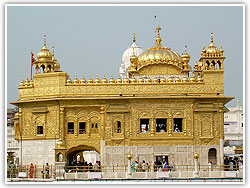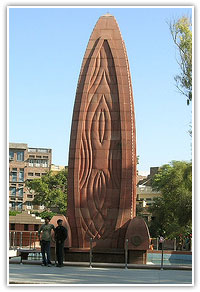|
Tourist
Attractions in Amritsar
The main tourist attraction in Amristar is the Golden
Temple. Besides, the Golden Temple, the Ram Bagh
Gardens, Jallianwala Bagh, Durgiana Temple and Baba Atal
Rai Tower are the various places which can be visited in
Amristar. |
|
The Golden Temple
The Golden Temple, the most important and holy
Sikh shrine, is located in the old part of the
town of Amritsar. The Golden Temple is also known
as Hari Mandir (Temple of the Lord). The temple is
surrounded by a pool, which gives the city its
name ‘Amritsar’, the pool of nectar. The
glittering golden domes of the temple are
reflected in the pool, and a marble pathway leads
to the temple. The temple domes are covered with
400 kilograms of gold. The gold was donated by
Maharaja
|
 |
|
|
Ranjit
Singh. This holy shrine is the spiritual nerve centre of
the Sikh faith and every Sikh tries to make a visit here
and bath in the holy water. The site has been sacred to
the Sikhs since the time of the fourth guru, Ram Das. In
1577, he heard that a cripple had been miraculously
cured while bathing in the pool here. This pool was
later enlarged and named Amrit Sovar, the pool of the
Nectar of immortality. Guru Arjun Das enlarged the tank
further and built the original temple at its centre in
1601. After building the temple, Arjun Das compiled a
collection of hymns of the great medieval saints and
this became the Adi Granth (Holy book). It was installed
in the temple as the focus of devotion and teaching.
Guru Gobind Singh, the tenth and last guru revised the
book and also refused to name a successor saying that
the book itself would be the Sikh guru. It thus came to
be known as the Granth Sahib. The Golden Temple suffered
twice at the hands of the Afghan Ahmad Shah Durrani, who
invaded northern India in 1747. After his departure, the
Sikhs reconquered the Punjab and restored the temple and
tank, under their greatest secular leader, Maharaja
Ranjit Singh. In 1830, he donated 100 kgs (220 lbs) of
gold which was applied to the copper sheets on the roof
and in the exterior of the building. The temple has
three floors. The ground floor with its fine silver
doors contains the Holy Book which has been placed on a
platform under a jewel encrusted canopy. Professional
singers and musicians perform verses from the book and
sing the hymns continuously. On the first floor is a
balcony on which three respected Sikhs are always
performing the Akhand Path (Unbroken Reading). In order
to preserve unity and maintain continuity, there must
always be someone who practice devotions. In the top
floor, the gurus used to sit and perform the Akhand
Path. Throughout the day, pilgrims place their offerings
of flowers or money around the book. The marble walls
are decorated with mirror work, gold leaf and designs of
birds, animals and flowers in semiprecious stones in the
Mughal style. The rest of the temple is covered with
gilt copper inscribed with quotations from the Granth.
Inside the temple compound, there is
a tree shrine, along the pathway. This gnarled jubi tree
is 450 years old and is reputed to be the favourite
resting place of the first chief priest of the temple,
Baba Gujhaji. Although he was chief priest, he would
still do voluntary and building work. Now, the women tie
strings to branches hoping to be blessed with a son by
the primeval fertility spirits that choose such places
as their home. It is also a favourite spot to arrange
and sanctify marriages, despite the protests of the
temple authorities. Inside the shrine, there are also
the flagstaffs, the shrine of Guru Gobind Singh and the
Akhal Takht. Further round on the eastern side are the
Sixty Eight Holy Places which comprises a number of
shrines and booths. This place takes its name from the
68 Hindu pilgrimage spots. When the tank was built Arjun
Singh told his followers that rather than visiting all
the Hindu places, they should just bathe here. The merit
that they would acquire would be equivalent to visiting
all 68 places. There is also a dining hall, kitchen,
assembly hall and Dharamshala in the premises. |
|
Jallianwala Bagh
Jallianwala Bagh is situated just a five minutes
walk from Golden Temple. It is the place where the
British General Dyer, massacred 300 innocent
people who had gathered there for a meeting on
April 13, 1919. The mass massacre took lives of
over 2000 unarmed people, who gathered there for
meeting. The tragic even later led to the
strengthening of the movement for total
independence. This garden commemorates the
martyrs, keeping the tragic episode in its
historical context. Today, this site of brutal
massacre, encloses a memorial with an eternal
flame, dedicated to the martyrs. The walls are
pockmarked with bullets and the well which some
tried to hide in can be seen.
Ram Bagh Gardens
The Ram Bagh Gardens contains a museum that houses
weapons dating from the Mughal times and
|
 |
|
|
some
portraits of rulers of Punjab. The building is a small
palace built by Maharaja Ranjit Singh.
Baba Atal Rai Tower
Baba Atal Rai Tower is built in the memory of the 9
years old son of Guru Hargobind, who martyred himself.
Durgiana Temple
Durgiana Temple is located outside the Lohagarh gate of
the old city. The temple is dedicated to Goddess Durga
and is a centre of pilgrimage for devout Hindus. |